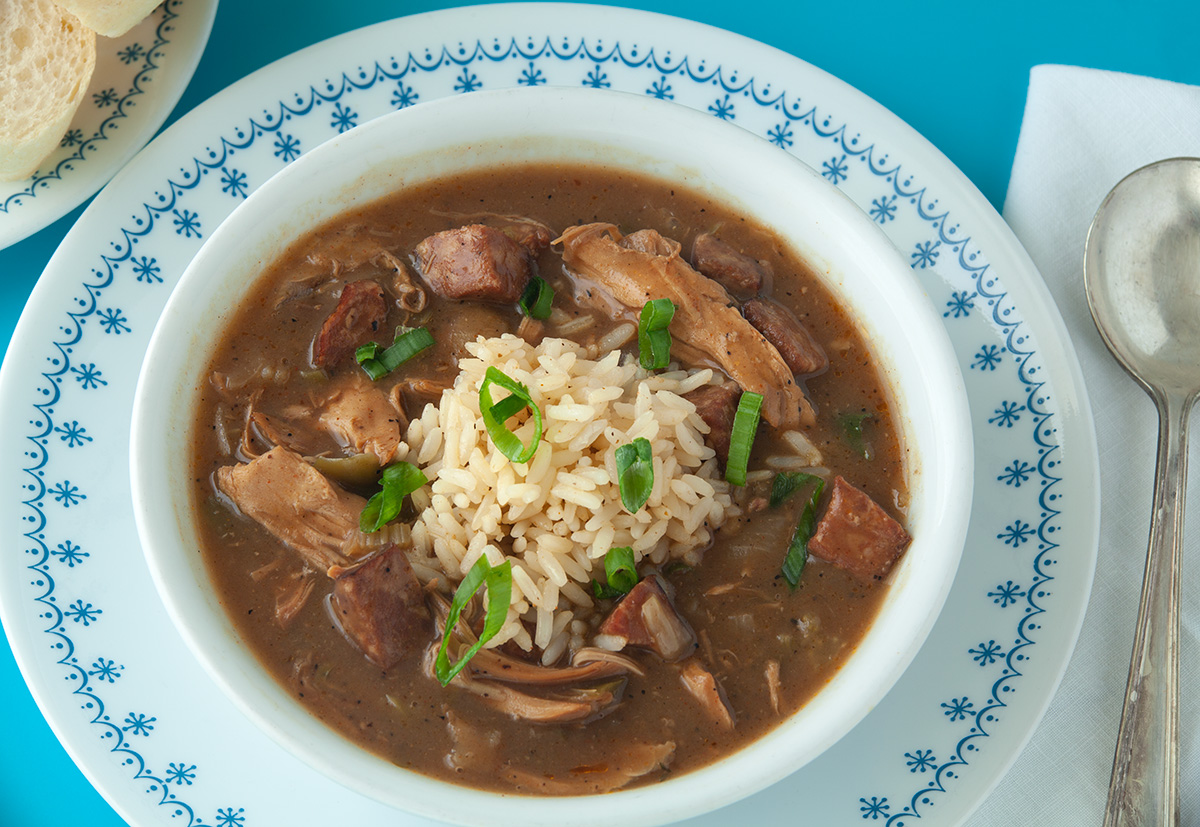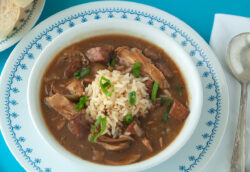Gumbo
Gumbo is a thick soup that could be considered the signature dish of South Louisiana.

The Louisiana Endowment for the Humanities
A bowl of chicken and sausage gumbo, 2023. Melissa Carrier, photographer.
Gumbo is a thick soup that could be considered the defining dish of South Louisiana, and yet, there is no standard recipe, as the dish straddles both Creole and Cajun cuisines, racial lines, and, in more recent times, even the boundaries of Louisiana. Gumbo’s varied history reflects the evolution of agricultural production and creolization, a hybridized blending of multicultural traditions, in Louisiana. Louisiana cuisine, as writer Lafcadio Hearn understood it in the late nineteenth century, is “cosmopolitan in its nature, blending the characteristics of the American, French, Spanish, Italian, West Indian, and Mexican.” While gumbo can be as varied as the cooks who prepare it, there are three essential varieties: seafood, poultry, and gombo z’herbes. The indigenous Louisiana repast is an emblem of cultural pride and distinctiveness.
Origins of Gumbo
The term gumbo is loaded with meaning. To be sure, it refers to the dish itself. But, “having a gumbo” can also denote the social event during which the soup will be served. Historian Gwendolyn Midlo Hall suggests that the term gombo,from a West African dialect prevalent among the Bambara ethic group, translates as okra—a common ingredient in gumbo because of its thickening properties. Indeed, both okra and the Bambara arrived in Louisiana as a consequence of the transatlantic slave trade. Moreover, plantation owners specifically targeted those very same enslaved people in an effort to transplant the traditional rice cultivation techniques in West Africa to Louisiana as a method of feeding the enslaved population at large. French, Spanish, and German immigrants also imported culinary traditions into the Louisiana territory over time. The base ingredient of most gumbos is a roux, a simmered mixture of fat and flour that serves as a thickening agent common in French preparations. Charcuterie, on the other hand, is part of all three culinary repertoires. Some cooks also include filé, or ground sassafras, borrowed from Native American cooking traditions, as yet another thickener.
By the time of the Louisiana Purchase in 1803, gumbo had become deeply ingrained in the local diet. The dish was prevalent among Cajuns, Creoles, and people of color, no matter their socioeconomic station. The first documentation of gumbo in Louisiana came from the pen of French immigrant and travel writer C. C. Robin in 1803. Robin attended a Cajun bal de maison (house dance) along the so-called Acadian Coast, the stretch of the Mississippi River between Baton Rouge and New Orleans, where his working-class hosts served gumbo to their guests.
That same year, at a Louisiana Purchase gala, the French government’s official representative, Pierre Clément de Laussat, ate gumbo, not in a working-class shanty, but among dignitaries in the regal confines of a New Orleans state room. “Such an abundance of spices!” he exclaimed. “Such overpowering seasoning! Creole cooking is calculated to burn the palate!” By the turn of the nineteenth century, the amount of piquancy in Louisiana cuisine had achieved striking levels, even for the palate of someone from southern France like Laussat. By the Civil War, gumbo had made its way onto restaurant menus like H. LeBlanc’s Oyster Saloon in Plaquemine, which served “‘Ironsides Gumbo’ and Gumbo of every other description.”
During the late nineteenth through the turn of the twentieth century, gumbo recipes appeared in some of Louisiana’s first cookbooks, including Lafcadio Hearn’s La Cuisine Creole (1885), the Times-Picayune’s The Picayune’s Creole Cookbook (1901), and Célestine Eustis’s Cooking in Old Créole Days (1903). These cookbooks hint at the range and scope gumbo recipes had taken since the moment of its first documentation.
Gumbo Variants
Before refrigeration, gumbo recipes varied according to the availability of resources within a particular region. Peoples living near waterways and the Louisiana coast, who had better access to seafood, flavored their pots, as Lafcadio Hearn documented, with “[o]ysters, crabs, and shrimp…when in season, as all improve the gombo.” Seafood gumbo recipes often included okra and tomatoes. In the late nineteenth century, Hearn noted that cooks would “[c]hop up three dozen okra pods, two onions, a pod of pepper, and a little parsley, and fry them brown in a little lard or butter; add to the okra the shrimps and the strained water in which they were boiled.”
Along the prairie regions of southwestern Louisiana, poultry-based gumbos predominated. Fallow hens, roosters, and guineas from the farm, or duck and geese from hunting expeditions, constituted the main ingredient of this roux-based variety. Sausage—either the smoked or “fresh” variety, depending on local custom—generally rounded out this dish.
During lean times or Lent—and in particular ethnic enclaves including Afro-Creole and German communities—gombo z’herbes filled local stockpots. Sometimes called gumbo verde or gumbo maigre, this vegetarian gumbo often included mustard greens, collard greens, turnip tops, beet tops, spinach, and parsley. German communities in Louisiana traditionally prepared this dish on Holy Thursday.
The indigenous Louisiana repast is now such an ingrained part of the state’s cultural heritage that it has become part of the local vernacular vocabulary. Louisianans will often proclaim that it is “gumbo weather” when the barometer drops. There is even a restaurant in New Orleans, The Gumbo Shop, devoted to the versatility of the dish. But gumbo is also now on menus around the world, a testament to Louisiana’s enduring global influence.
